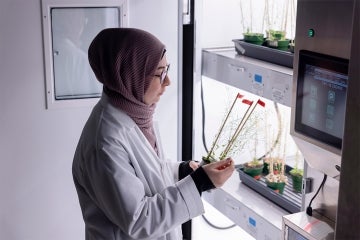
How Canada helped China rebuild universities after the Cultural Revolution
Published: July 14, 2014
The end of the Cultural Revolution. The trial of the Gang of Four. The Tiananmen Square protests. The transfer of Hong Kong from Britain to China.
Ruth Hayhoe, a professor at the Ontario Institute for Studies in Education, has been present at some of the most dramatic events in recent Chinese history.
Hayhoe has been drawn to China since 1967 when, as a recent U of T classics graduate, she accepted a teaching position in Hong Kong. She learned Cantonese and Mandarin – “maybe the fact that I had already learned Greek and Latin made it less daunting” – and decided to devote her life to the study of China and its culture rather than classics.
Since then she’s lived and worked in China off and on for more than 30 years; as a foreign expert at Fudan University in Shanghai, as head of the Canadian embassy’s cultural section in Beijing, and as director of the Hong Kong Institute of Education. During that time she’s been witness to important events such as the trial of Mao Zedong’s wife Jiang Qing in 1981, the demonstrations at Tiananmen Square in 1989, and the transfer of Hong Kong sovereignty from the United Kingdom to China in 1997.
Though she’s seen firsthand several famous events in recent Chinese history, something more forgotten piques her interest these days – the role that Canada played in China’s resurgence since the 1980s.
Beginning in the early 1980s, Canadians collaborated with Chinese colleagues in areas such as management education, agriculture, health, the environment and higher education teaching; helping China rebuild and launch a period of phenomenal growth, Hayhoe maintains.
“Canada was a major player in the rebirth of Chinese universities after the Cultural Revolution, and that’s largely forgotten,” she says.
Hayhoe recently co-organized a conference at Tsinghua University in Beijing to recall and evaluate that legacy. She says Canada should be proud of its contribution, and so should the University of Toronto, which helped China develop skills in management, the environment and education at all levels.
"A Chinese official once said to me that after the Cultural Revolution, they had 300,000 enterprises moving into the market economy and had nobody to lead them except Marxist economists and Soviet-trained engineers,” Hayhoe recalls. “U of T’s management school was involved from the first. A whole structure of training Chinese MBAs and developing management as a field came out of that Canadian cooperation,” she says. “And now it’s largely forgotten.”
Besides U of T, other Canadian universities were involved, in areas such as medicine, engineering, agriculture and education.
“Some very striking developments came out of that collaboration, including the development of Canola – which resulted from a partnership between the University of Manitoba and the Central University of Agriculture.”
Hayhoe herself was part of that effort, as she was involved in OISE’s efforts to help China train doctoral students in education. “Under the old Soviet-influenced regime, they didn’t have doctorates as they were known in the west. There were a number of very elderly scholars, who were plucked out of obscurity after the Cultural Revolution, but they had been out of touch for years.” OISE didn’t grant the degrees, instead providing support such as graduate supervision and access to the OISE library.
Canada’s unique role in China’s resurgence came about because of its early establishment of diplomatic relations with China, and a decision by the Canadian International Development Agency (CIDA) to fund development projects in China, Hayhoe says.
Ironically, other countries such as England and Australia are now benefiting from Canada’s investment in Chinese education in the 1980s, while Canada is now a much smaller player, she says.
Hayhoe’s new book, China through the Lens of Comparative Education, is the first book by a Canadian scholar and the first about China's education to appear in Routledge's prestigious World Library of Educationalists.
Out of Hayhoe’s experience as an educator in both China and Canada has come an interest in bridging the contrasting educational and philosophical worlds of East Asia and North America. She dismisses the stereotype that Chinese students are less questioning and more deferential to authority than their western counterparts.
“It’s not that they don’t question, it’s that they absorb what they’re reading at a deep level before they react, whereas western students almost immediately tend to jump in and question. It’s a different sort of pace of interaction, but there can be quite a deep connection and reflection and sharing that goes on between students and faculty.”
Almost 50 years after she first travelled to Hong Kong as a young teacher, Hayhoe still visits China frequently. “It’s been a very blessed life, and I’m so grateful to the university which has given me a wonderful base from which to work.”
Terry Lavender is a writer with University Relations at the University of Toronto.



